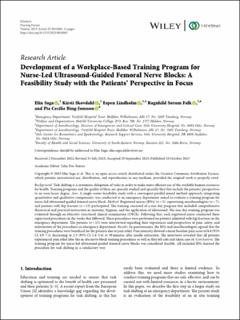| dc.contributor.author | Saga, Elin | |
| dc.contributor.author | Skovdahl, Kirsti | |
| dc.contributor.author | Lindholm, Espen | |
| dc.contributor.author | Sørum Falk, Ragnhild | |
| dc.contributor.author | Bing-Jonsson, Pia Cecilie | |
| dc.date.accessioned | 2023-10-24T11:23:13Z | |
| dc.date.available | 2023-10-24T11:23:13Z | |
| dc.date.created | 2023-10-13T06:04:24Z | |
| dc.date.issued | 2023 | |
| dc.identifier.citation | Saga, E., Skovdahl, K., Lindholm, E., Sørum Falk, R. & Bing-Jonsson, P. C. (2023). Development of a Workplace-Based Training Program for Nurse-Led Ultrasound-Guided Femoral Nerve Blocks: A Feasibility Study with the Patients’ Perspective in Focus. Nursing Forum, 2023, Artikkel 8810083. | en_US |
| dc.identifier.issn | 0029-6473 | |
| dc.identifier.uri | https://hdl.handle.net/11250/3098377 | |
| dc.description.abstract | Background: Task shifting is a systematic delegation of tasks in order to make more efficient use of the available human resources for health. Training programs and the quality of these are sparsely studied and specially they that include the patients’ perspectives to an even lesser degree.
Aim: A single-center feasibility study with a convergent parallel mixed method approach, integrating quantitative and qualitative components, was conducted at an emergency department aimed to evaluate a training program for nurse-led ultrasound-guided femoral nerve block.
Method: Registered nurses (RNs) (n = 5), supervising anesthesiologists (n = 7), and patients with hip fracture (n = 15) participated. The training consisted of a one-day program that included comprehensive theoretical and practical instruction in anatomy, hygiene, and the application of ultrasound. The one-day training program was evaluated through an objective structured clinical examination (OSCE). Following that, each registered nurse conducted three supervised procedures in the weeks that followed. These procedures were performed on patients admitted with hip fractures in the emergency department. The patients (n = 15) were interviewed regarding their experiences and perspectives of pain, safety, and information of the procedures in emergency department.
Results: In questionnaire, the RNs and anesthesiologists agreed that the training procedures were beneficial for the patients due to pain relief. Pain intensity showed a mean baseline pain score of 6.0 (95% CI 4.9–7.1) decreasing to 2.5 (95% CI 1.4–3.6) at 30 minutes after needle extraction. The interviews revealed that all patients experienced pain relief after the in situ nerve block training procedures as well as they felt safe and taken care of.
Conclusions: The training program for nurse-led ultrasound-guided femoral nerve blocks was considered feasible. All included RNs learned the procedure for task shifting in a satisfactory way. | en_US |
| dc.language.iso | eng | en_US |
| dc.rights | Navngivelse 4.0 Internasjonal | * |
| dc.rights.uri | http://creativecommons.org/licenses/by/4.0/deed.no | * |
| dc.title | Development of a Workplace-Based Training Program for Nurse-Led Ultrasound-Guided Femoral Nerve Blocks: A Feasibility Study with the Patients’ Perspective in Focus | en_US |
| dc.type | Journal article | en_US |
| dc.type | Peer reviewed | en_US |
| dc.description.version | publishedVersion | en_US |
| dc.rights.holder | © 2023 Elin Saga et al. | en_US |
| dc.source.volume | 2023 | en_US |
| dc.source.journal | Nursing Forum | en_US |
| dc.identifier.doi | https://doi.org/10.1155/2023/8810083 | |
| dc.identifier.cristin | 2184283 | |
| dc.source.articlenumber | 8810083 | en_US |
| cristin.ispublished | true | |
| cristin.fulltext | original | |
| cristin.qualitycode | 1 | |

